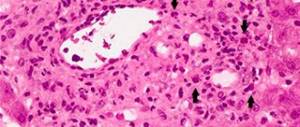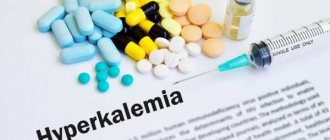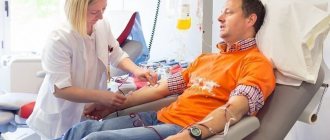An English medical journal published the results of a study examining the relationship between glycated hemoglobin and mortality rates in men.
The experiment involved 4,662 volunteers aged 45-79 years, most of them did not suffer from diabetes. Among men whose HbA1C did not exceed 5% (the norm for an adult), mortality from heart attack and stroke (the main causes of death for diabetics) was the lowest. Each additional percentage of glycated hemoglobin increased the likelihood of death by 28%.
According to this statistic, 7% HbA1C increases mortality by 63% compared to normal levels. But with diabetes, 7% is quite a decent result!
According to epidemiological observations, there are at least 8 million diabetics in Russia (90% have type 2 diabetes), 5 million of them are not even aware of high sugar in their blood. All types of sugars are aggressive oxidizing agents that destroy blood vessels and tissues of the human body, not to mention the fact that a sweet environment is an ideal condition for the proliferation of bacteria.
But, at the same time, glucose has always been and will be the main source of energy for muscles, brain, and organs. How to find this golden mean that allows you to be healthy with a refined diet and inactive lifestyle of most of our contemporaries?
Why does blood sugar rise?
The causes of high blood sugar are very varied. For example, temporary hyperglycemia (detected once) can be caused by:
- Overeating (especially abuse of foods rich in easily digestible carbohydrates).
- Stress.
- Pain syndrome.
- Major blood loss.
Causes of high blood sugar:
- diabetes mellitus is one of the most common causes;
- overeating, predominance of easily digestible carbohydrates in the diet;
- stressful situations;
- severe infectious diseases.
It is quite obvious that in diabetes mellitus hyperglycemia is long-lasting and affects the condition of many organs and systems, but we will talk about this later. First, let's figure out what signs can be used to suspect an increase in blood glucose.
There is diet No. 9, which is designed specifically for people with high blood sugar. Its goal is to normalize glucose levels, obtain nutrients, vitamins and microelements.
If it is strictly followed immediately after the disease is identified, there is a high chance of stopping the development of pathology. In the diet, it is necessary to limit the consumption of foods with significant amounts of carbohydrates.
In this case, the supply of glucose will be reduced and less insulin will be required. There will be a decrease in blood sugar levels, which will contribute to the normal functioning of the whole body.
Low glucose levels
This phenomenon can be observed due to insufficient intake of simple carbohydrates into the body (for example, during diets). Sugar levels also drop noticeably immediately after training or heavy physical work. A deficiency of this substance in the blood is not uncommon for nursing mothers, since they “share” it with their child.
It should be especially noted that if sugar remains low for a long time, this can lead to a hypoglycemic state. By the way, such a deviation is observed not only after heavy physical exertion or with a lack of carbohydrates, but also in cases of disturbances in the functioning of the pancreas, liver or kidneys.
Reasons for jumps
Blood sugar in men is determined by examining venous blood or capillary blood from a finger. For the result of such an analysis to be reliable, it is required that at least 8 hours have passed since the last meal.
It is recommended to take the test in the morning on an empty stomach; you should not smoke or drink coffee before the test, eliminate emotional stress, and stop playing sports.
The level of high blood sugar in men is diagnosed at values exceeding 5.85 mmol/l between the ages of 14 and 60 years, and 6.35 mmol/l after 60 years.
In men
- The reasons why sugar increases are as follows:
- Disorders of the digestive system, especially the pancreas, for example, pancreatitis, tumors. As well as injuries to the pancreas caused by mechanical stress.
- Heredity. If someone in the family suffered from high sugar, then there is a high probability of inheriting this condition.
- Situations leading to severe stress, anxiety, and excitement.
- The predominance of a large amount of carbohydrates in the diet, especially simple ones that are easily digested.
- Lack of physical activity, sedentary lifestyle, and intense sports.
- Smoking and alcohol.
- Endocrine disorders in which various diseases develop, for example, diabetes.
- Taking medications such as diuretics, contraceptives, various medications that contain hormones.
- Liver diseases, for example, oncology, cirrhosis.
- For some time, sugar may increase under the following conditions: severe pain, epileptic attack, angina pectoris, heart attack, traumatic brain injury, surgery on the digestive organs.
The increase in sugar may be temporary, returning to normal after the cause is eliminated. If this condition continues for a long time, then you need to consult a doctor. To find out your sugar level, you need to get tested regularly.
Physiological reasons
Blood glucose levels can fluctuate due to pathologies of internal organs and exposure to external factors.
Among somatic diseases, diabetes mellitus occupies the main place. Elevated blood sugar is the main symptom of this disease. Another pathology that leads to a constant increase in glucose is obesity. Chronic liver and kidney diseases can also cause high blood sugar levels.
There can be several reasons for sudden surges in sugar. The most common ones are:
- poor nutrition;
- stress;
- infectious diseases, the progression of which disrupts the functioning of internal organs;
- lack of physical activity.
These reasons provoke changes in indicators even in healthy people. It is possible to discover that a healthy person’s blood sugar is jumping by accident. Usually the races do not cause any problems and are practically asymptomatic. But over time, such a person will develop diabetes.
Failure to follow a diet and consumption of large amounts of fast carbohydrates and fats leads to the fact that the pancreas needs to work harder and produce a significant amount of insulin. Over time, hormone synthesis may decrease and the patient's sugar levels will increase.
With sedentary work and lack of sports in life, the likelihood of excess weight increases. Significant levels of visceral fat reduce the uptake of insulin into cells, so glucose concentrations may increase.
In stressful situations, the body inhibits the process of insulin production. At the same time, glycogen begins to be released from the liver. This together leads to an increase in the amount of sugar in the blood.
Under the influence of these factors, diabetes may develop, this will be indicated by constant high glucose levels.
In type 1 disease, constant slight fluctuations in glucose levels are normal. The pancreas cannot cope: it does not produce insulin or produces it in small quantities. Diabetics with T1D need regular insulin injections to manage their diabetes.
In the second type of disease, an increase can be triggered by stress, poor diet, lack of physical activity and other factors. Why does sugar spike in type 2 diabetes? The decrease is provoked by the following reasons:
- development of persistent pain syndrome;
- infectious lesions in which the temperature rises;
- the appearance of painful burns;
- convulsions;
- epilepsy;
- hormonal imbalances in the body;
- problems with the digestive system.
These reasons provoke glucose surges in both healthy people and diabetics. Patients with diabetes should know the signs of hypoglycemia and hyperglycemia in order to detect them in time.
A persistent increase in blood glucose is not always observed.
Sometimes sugar increases when taking medications, burns, etc.
After the cessation of exposure to the provoking factor, the glycemic level returns to normal.
A short-term increase in sugar can be observed with excessive physical exertion, severe stress, prolonged pain, bacterial and viral diseases, and high body temperature. Let's look at the most common reasons.
Taking and influencing medications
Hyperglycemia can be caused by the following groups of drugs:
- diuretics of the thiazide group. For example, Indapamide;
- beta blockers used to treat cardiovascular disorders. In particular – Carvedilol and Nebivolol;
- glucocorticoids. Can sharply increase plasma sugar levels;
- hormonal pills;
- oral contraceptives;
- some psychotropic substances;
- steroidal anti-inflammatory drugs. This is especially true for Prednisolone. Long-term use leads to steroid diabetes.
Risk factors that can cause high blood sugar include:
- genetic predisposition;
- poor nutrition (especially consumption of large quantities of baked goods and sweets);
- irrational use of medicines;
- bad habits (especially alcohol abuse);
- heavy blood loss;
- deficiency of vitamins in the body (especially B1 and C);
- excessive physical activity;
- carbon oxide poisoning;
- frequent stressful situations.
With the development of gestational diabetes in the early stages of pregnancy, there is a risk of developing fetal pathologies, including serious ones.
Reasons for increased glucose levels
A factor in the progression of pathology is the deterioration of the process of carbohydrate absorption. The pancreas “reacts” to an excess of the element by producing insulin. Among the causes of impaired glucose tolerance are:
- Hereditary predisposition. If one or both parents are diagnosed with diabetes, the child may also develop the disease later on.
- Instability to stress. “Nervous” situations provoke “emergency” production of hormones. Suffering severe stress can lead to irreversible consequences, including the progression of previously undiagnosed diabetes mellitus.
- Having excess weight. Obesity is a dangerous risk factor, and the more extra pounds, the higher the risk.
- Inactivity. For normal functioning, vital systems need a full load; in its absence, toxins begin to accumulate in the digestive and genitourinary systems. The result is an increase in glucose in the blood and urine. In women, this phenomenon occurs more often than in men, due to the characteristics of hormone production.
- Excessive physical activity. Unfortunately, intense exercise also leads to the formation of pathologies, since the body cannot cope with the given regime.
- Gastrointestinal diseases affecting the functioning of the pancreas. Diseases of the digestive system lead to disruption of the process of insulin production and, accordingly, to an increase in glucose levels.
- Pathologies of the endocrine system, most often the thyroid gland. This phenomenon is accompanied by the active “production” of counter-insular hormones, which leads to intense insulin production.
- Taking certain pharmaceuticals, especially those based on hormones (contraceptives, glucocorticoids, etc.).
- Age-related changes. The development of pathological changes in the body and an increased tendency to produce insulin is observed in patients after 50 years of age.
Important! Pregnant women are at risk. Pregnancy is accompanied by changes in the hormonal system, so even if before conception the glucose level was within the normal range, during pregnancy it can change in a critical direction. To avoid negative consequences, it is advisable to test the sugar levels in the blood and urine at least once every trimester.
Diabetes mellitus in children
The disease in children manifests itself in a severe form - type 1 diabetes. If any signs indicating illness appear, you should immediately visit a doctor and get tested for blood sugar.
In children, this disease is asymptomatic for a long period, so the diagnosis is made only in the severe form of its development. By this time, damage to the blood vessels of the eyes, oral mucosa, nervous system, skin occurs, and sometimes a coma develops.
Symptoms of high blood sugar in children are the same as in adults:
- constant dry mouth, severe thirst;
- fatigue;
- constant feeling of hunger;
- copious and frequent urination;
- losing weight with a good appetite.
Who is at risk for decreased glucose tolerance?
The process of carbohydrate metabolism and the risk of excess insulin production threatens not only people with a congenital predisposition and the above risk factors. It is recommended to regularly take sugar tests if you have previously been diagnosed with:
- diseases of the liver, heart, blood vessels and intestines,
- increased blood lipid levels,
- hypothyroidism,
- gout,
- atherosclerosis,
- high cholesterol levels.
Low blood sugar
Such diseases do not mean the presence of diabetes mellitus (even at an early stage), but indicate that the body is predisposed to its occurrence. The only way to protect yourself is timely examination and prevention of pathology.
High Level Signs
There are certain symptoms that indicate high blood sugar levels.
Among them are:
- Frequent urination (this increases the amount of urine);
- Constant feeling of thirst, even at night (this also applies to dry mouth);
- Constant fatigue, weakness, lethargy;
- Feeling of nausea, which very rarely causes vomiting;
- Frequent and prolonged headaches;
- Weight problems.
- Rarely, vision may become worse with low blood sugar.
1. The main symptom is constant thirst.
Due to high blood sugar levels, a person wants to drink constantly. Glucose draws water from peripheral organs and tissues.
When the level of glucose in the blood rises above 10 mmol/l (renal threshold), it begins to be excreted in the urine, taking with it water molecules. As a result, frequent urination and dehydration.
Of course, the body tries to compensate for the loss of water by drinking plenty of water.
2. Dry mouth.
This symptom is associated with excessive fluid loss.
3. Headache.
Insufficient glucose levels in the body cause neurological, autonomic and metabolic disorders. They usually appear when the level drops to 3 mmol/l. If its concentration drops to 2.3, the patient will fall into a hypoglycemic coma.
Signs of a drop in glucose concentration include:
- headaches;
- anxiety;
- hand tremors;
- sweating;
- feeling of irritation;
- constant hunger;
- nervousness;
- tachycardia;
- muscle tremors;
- pulsation in the head and periphery;
- dizziness;
- decreased blood pressure;
- loss of sensation in some areas;
- partial loss of motor activity.
Hypoglycemia can develop due to:
- intense physical activity;
- taking certain medications (tetracycline antibiotics, vitamin B6, anabolic steroids, sulfonamides, calcium supplements);
- drinking alcohol.
If hypoglycemia is not recognized in time and the necessary measures are not taken, the patient will fall into a coma. Patients do not have much time; with this pathology, people lose consciousness quite quickly. Brain cells stop receiving energy and neurological disorders begin.
Increased glucose during pregnancy: symptoms and precautions
Pregnancy is a period of change. Moreover, both psychological and physiological. From anatomy courses and life experience, people know that during the intrauterine development of the fetus, active hormonal “changes” occur. However, few people pay attention to the risk factor for increased glucose in blood and urine.
Important! Pregnant women need to be tested for sugar regularly. According to statistics, 3% of women expecting a child have gestational diabetes. Without timely treatment, the risk of developing the disease increases.
The appearance of gestational diabetes is provoked by:
- Poorly prepared diet. The myth that pregnant women need to eat whatever they want (that’s what the baby wants) is a huge mistake. Even foods that are safe in everyday life can lead to an increase in glucose levels, so it is necessary to create a menu taking into account physiological characteristics and in accordance with the specifics of pregnancy.
- Excess weight. Excess kilograms affect the functioning of all vital systems. If a tendency toward obesity appears after 18 years of age, it is advisable to increase control over sugar levels in the blood and urine.
- Age over 30 years. The optimal reproductive period is 20-27 years. Next, age-related changes begin, against the background of which pregnancy can become a risk factor for diabetes.
- History of high blood pressure.
- A hereditary tendency to increase sugar in the body or the presence of a disease in one of the parents.
Blood sugar 8 mmol
Expectant mothers with a large baby are also at risk. The birth of a child weighing more than 4 kg is a huge stress for a weakened body. Accordingly, the ability to prevent the development of gestational diabetes without therapeutic intervention is minimal.
Remember! The absence of symptoms is not a reason to ignore a possible illness. The effectiveness of metabolic metabolism of carbohydrates should be mandatory for women over 25 years of age in the third trimester - 24-28 weeks of pregnancy - even if heredity and symptoms do not indicate a predisposition to diabetes.
Main symptoms of hyperglycemia
The main symptom of high blood sugar is extreme thirst and hunger. When glucose levels are high, the kidneys begin to work actively, leading to the removal of fluid and, as a result, dehydration of the body. In this case, there is frequent urination and constant thirst.
Hunger develops due to insufficiency of insulin, which processes carbohydrates into glucose. Due to increased appetite, weight gain begins. Therefore, sudden weight gain can also be a symptom of high blood sugar.
The main signs of a long-term increase in sugar:
- constant thirst (even when drinking a large amount of liquid), the inability to completely quench it;
- dryness of the mucous membranes of the oral cavity;
- frequent urge to urinate, increased volume of urine produced, night urination;
- decreased visual acuity;
- skin itching;
- weakness, fatigue;
- irritability;
- arrhythmia;
- dyspnea;
- causeless weight loss (even with adequate nutrition);
- smell of acetone from the mouth.
In addition, patients with hyperglycemia complain of numbness of the lips, numbness and coldness of the upper and/or lower extremities, causeless debilitating headaches, nausea, frequent constipation or diarrhea, dizziness, chills, flashing spots before the eyes, and susceptibility to infectious diseases.
In men with elevated sugar levels, sexual dysfunction and inflammation of the foreskin are common.
These signs allow one to suspect hyperglycemia, but the final diagnosis is established after examination.
Elevated blood glucose levels are characterized by the following symptoms:
- constant thirst;
- dry mouth, including at night;
- sudden weight loss or gain;
- need for frequent urination;
- chronic fatigue;
- headache;
- dryness of the dermis and mucous membranes;
- blurred vision;
- Heart arythmy;
- weakening of the immune system;
- poor wound healing;
- noisy breathing.
Symptoms of high glucose levels
The insidiousness of the disease is that it does not manifest itself in the early stages. It is possible to determine that glucose is elevated only by taking tests and confirming the deviation from the norm. Unfortunately, most people without obvious symptoms will not go to the hospital. As a result, the pathology may be detected too late.
It is recommended to consult a doctor and undergo the necessary tests in the absence of painful symptoms, but if you have:
- increased dryness of the skin,
- the appearance of itching of the skin in the external genital area,
- tendency to gum diseases: bleeding, inflammation, swelling,
- furunculosis,
- disorders of the menstrual cycle in women (up to the cessation of menstruation),
- problems with wound healing (low blood clotting),
- loss of sexual interest.
Ignoring such signs, especially against the background of excess weight and a tendency towards obesity, can lead to the progression of the pathology. An aggravated form of impaired glucose tolerance is characterized by the appearance of:
- strong obsessive thirst,
- constant dry mouth,
- increased urge to urinate,
- disruption of the immune system: inflammatory and fungal diseases appear more often.
Something to remember! At these stages, it is still possible to prevent the transition of increased glucose tolerance to diabetes mellitus. Moreover, with timely treatment, recovery occurs in 95% of patients. To do this, you need to take a course of preventive measures and eliminate the violation of carbohydrate metabolism.
Diagnostics
In addition to laboratory determination of the concentration of glucose in the blood, if the development of a pathological condition is suspected, a test for glucose tolerance (glucose tolerance test) is performed. In this test, fasting blood glucose levels are measured and the patient then takes glucose dissolved in water.
After this, several consecutive measurements are taken at intervals of 30 minutes. Normally, the glucose concentration two hours after a glucose load does not exceed 7.8 mmol/l.
At a glucose level of 7.8–11.0 mmol/l, the result is regarded as impaired glucose tolerance; at higher levels, diabetes mellitus is diagnosed.
To avoid distortion of test results, it is recommended to adhere to certain rules for its preparation:
- blood must be donated on an empty stomach, the last meal should be no later than 10 hours before the test;
- the day before the study, you should stop playing sports and avoid heavy physical activity;
- You should not change your usual diet on the eve of the study;
- Avoid stressful situations before taking the test;
- Get a good night's sleep the night before the test.
If hyperglycemia is suspected, patients are prescribed a general blood and urine test (with the detection of ketone bodies), tests for the determination of C-peptide, glycosylated hemoglobin, and antibodies to pancreatic β-cells.
For long-term elevated sugar levels, it is recommended to evaluate the function of the heart, liver and kidneys (ECG, ultrasound, etc.).
In order to exclude complications developing against the background of hyperglycemia, the patient, depending on the indications, is referred for consultation to an endocrinologist, ophthalmologist, urologist or gynecologist, cardiologist, or neurologist.
What should the sugar level be?
Glucose normally should be in the range from 3.3 to 5.5 mmol/l. But the physiological processes that continuously occur in the body during digestion can quite easily influence its level. This is due to the fact that after food enters the gastrointestinal tract, simple carbohydrates are immediately absorbed into the blood. In this case, complex substances are broken down into simple ones by enzymes, and then also enter the bloodstream. As a result of such chemical actions, sugar levels can significantly increase. Its excess amount goes to the liver. In between meals, when the glucose level drops noticeably, it is quickly removed from its “storage” to maintain the required minimum level.
Treatment
First of all, treatment is prescribed to lower blood sugar. Diabetes mellitus is treated with medications.
The first type of this disease is treated:
- Insulin, proper nutrition and diet.
- Insulin is used throughout life in the form of injections.
- The dose and medications are prescribed by the attending physician, who monitors the patient’s condition.
The second type of diabetes is treated:
- Using pills that lower blood sugar levels.
If you are prone to fluctuations in glucose levels, it makes sense to purchase a home glucometer. For diabetics, this device is a must.
You should immediately consult a doctor as soon as you notice an increase in blood sugar. Symptoms and treatment are clarified by a specialist. Additionally, the following analyzes are performed:
- standard blood or plasma test for sugar;
- glucose tolerance test;
- blood test for glycated hemoglobin.
Further methods of reducing indicators are selected on an individual basis.
First aid and therapy
People suffering from diabetes find it very difficult in everyday life. At any moment, the glucose level can become critical. In this case, first aid should be to lower its level below 11.5 mmol/l.
A special insulin injection will quickly help lower blood sugar. Additionally, the patient must be provided with plenty of fluids. It is best to use still mineral water with the addition of soda. This will help normalize water balance and remove toxins from the body.
People with hyperglycemia are prescribed medications to lower blood sugar. In case of diabetes, insulin injection is mandatory. Without a dose of insulin, the body is not able to process sugar normally, and a person may fall into a coma. Vitamins are also prescribed to support a weakened body.
A prerequisite is compliance with the diet. The menu should consist of foods with a low glycemic index.
Important: it is worth considering that the method of preparation and the combination of different products can also change the glycemic index.
You need to exclude foods that significantly increase blood sugar from your diet. What causes glucose to rise:
- sugar and sweeteners;
- sweets;
- flour products, especially baked goods;
- cheeses;
- pickles and marinades;
- lard and fatty meat;
- smoked meats and sausages;
- rice;
- potato;
- rich soups;
- semi-finished products;
- fast food;
- sweet sodas and packaged juices.
Create a daily menu from the following products:
- green tea;
- low-fat milk;
- eggs in moderation;
- chicken;
- liver;
- Fish and seafood;
- beans;
- lentils;
- buckwheat;
- salads and spinach;
- mushrooms;
- vegetables;
- citrus;
- fruits in moderation, except bananas and grapes.
Since it is difficult to quickly lower blood sugar without medications, such a diet should be maintained for at least a month. In the future, you need to protect yourself from harmful foods and control your glucose levels.
Folk remedies
In folk medicine, there are also many ways to lower blood sugar. Mostly the recipes are based on the use of herbal infusions. Some plants are able to stimulate the production of insulin and remove excess glucose, as well as have a symptomatic effect on the body. You can buy a similar mixture at any pharmacy or prepare it yourself.
Eating right can stabilize your sugar levels. You should avoid junk food and monitor the glycemic index, which indicates which foods are strictly prohibited.
Determination methods
A basic test for sugar content is carried out by collecting venous or capillary (from a finger) blood on an empty stomach. In case of deviations from the norm, extended blood microscopy is prescribed, including:
Using a glucose tolerance test, the level of glucose absorption by the body's cells is determined. The analysis is carried out in two stages: an initial blood sample on an empty stomach, and a second blood sample two hours after exercise. As a load, the patient drinks an aqueous solution of glucose (75 g per 200 ml of water). The results are assessed through comparison with standard indicators.
Glycated (glycosylated) hemoglobin is the result of the interaction of glucose and protein (hemoglobin). HbA1C analysis evaluates sugar levels in retrospect, over the past 120 days - the lifespan of red blood cells. The HbA1C test result is determined according to the patient's age. The normal indicator up to 40 years is
| Age | Norm | Limit level | Deviation | ||
| 40+ | 7,5% | ||||
| 65+ | 8,0% | ||||
If glucose tolerance is impaired, prediabetes is diagnosed - a condition in which sugar levels are consistently elevated, but do not “reach” the norms for diabetic values. Prediabetes is not an official disease, but nevertheless requires emergency treatment to prevent true type 2 diabetes from developing.
Treatment for high blood sugar
What to do if the examination reveals a high level of glucose in the blood is decided only by specialists. Endocrinologists treat diabetes mellitus.
Therapy for high blood sugar involves eliminating the cause of this condition. In most cases, after treatment of concomitant pathologies, the glucose value returns to normal.
If diabetes mellitus has been diagnosed, then for type I, insulin injections are prescribed, for type II - oral administration of glucose-lowering drugs.
A special diet is of great importance in correcting blood glucose levels. It includes the concept of a bread unit, which corresponds to 10 g of carbohydrates. There are special tables designed for diabetics. They describe the correspondence between main products and grain units.
Sweets, sugar, white bread and flour products, and certain cereals are excluded from the diet. In this case, the diet should be balanced and contain the necessary microelements and fatty acids. Fatty meat and fish, smoked foods, milk, sweet fruits and berries are prohibited.
It is advisable to eat in small portions. There should be 5-6 meals per day. This way carbohydrates are better absorbed, which has a positive effect on fluctuations in glucose levels.
With elevated sugar levels, your overall health also worsens. Glucose is not absorbed, therefore, the energy required for the normal functioning of the body decreases.
Ways to stabilize glycemia
For type 1 diabetics, when glucose levels rise, it is recommended to give an emergency insulin injection. The dose is determined by the doctor, according to the prescribed treatment regimen. Acute conditions of hyperglycemia in diabetic patients are treated in a hospital setting. If there is a single physiological deviation of glucose levels from the norm, it is necessary to take care of the trigger that increases sugar (stress, poor diet, excessive alcohol consumption) and eliminate it.
What to do to neutralize hyperglycemia: adjust eating behavior and diet, rationally engage in feasible sports and walk in the fresh air, use herbal remedies of traditional medicine. A mandatory condition for treatment is a complete abstinence from nicotine and alcohol-containing drinks.
Diet therapy
Basic principles of organizing a healthy diet:
- Eliminate simple carbohydrates (sweet foods and drinks) from the menu, which can sharply increase the glycemic level.
- Avoid fatty and spicy foods (pork, mayonnaise-based sauces, sausages, canned products).
- Avoid foods prepared by frying.
- Introduce into the daily menu foods that curb glycemia (jerusalem artichoke, chicory, cinnamon, forest and garden berries, cabbage of all varieties, green beans, etc.).
- Maintain a drinking and eating regimen (1.5–2 liters of fluid and six meals a day in small portions).
The ratio of nutrients in the daily diet should be within the following limits: carbohydrates - 45%, proteins - 20%, fats - 35%. The total daily caloric intake is 2200–2500 kcal. The menu is developed taking into account the glycemic index of each product (the rate of formation and absorption of glucose). When sugar levels rise, products indexed from 0 to 30 units are allowed.
Physical education and sports
Regular physical activity and sports training help maintain stable glucose levels. The lesson plan should be developed taking into account the capabilities (overexertion is unacceptable). Exercise therapy groups are organized for diabetics. For independent training, Finnish walking, daily exercises, swimming and water aerobics are suitable. Physical activity increases the access of oxygen to cells and tissues, gets rid of extra pounds, and eliminates impaired glucose tolerance.
Folk remedies
For high sugar levels, infusions and decoctions of medicinal herbs, wood raw materials (buds, bark, leaves of medicinal plants), and beekeeping products are used. The most popular folk remedies for lowering glucose include:
- Buds (lilac and birch).
- Hazel bark.
- Leaves (currant, laurel, walnut, blueberry grape).
- Dried walnut partitions.
- Dandelion and burdock roots.
- St. John's wort.
- Goat's rue (rue, galega).
- Cuff and others.
What to take from folk remedies?
When high blood sugar is detected in a person, all the reasons for this are known, how then to treat with folk remedies? If the patient's glucose level is minimally elevated, then in order to complement the main treatment, the therapist will recommend using treatment with various herbs.
Herbal tea drinks can lower sugar. Suitable tea is made from blueberry leaves, hibiscus, and sage.
To treat high blood sugar, you need prescriptions to know how to treat it at home.
Sugar imbalance: consequences
Any persistent imbalance (homeostasis) in the body leads to pathology. The exception is glucose levels.
Hyperglycemia and hypoglycemia cause painful symptoms that often lead to incurable complications or disability.
Will the beneficial properties of honey allow it to be included in the diet of a diabetic? Causes and symptoms of type 1 diabetes. Read more here.
Which fruits can diabetics eat and which should they avoid?
High sugar
The popular opinion that diabetes mellitus is the result of excessive consumption of sweets is not entirely true, but it definitely contains a rational grain.
While the amount of glucose increases gradually, insulin is also produced slowly. But when, as a result of a large amount of carbohydrate-rich food, an excess number of sugar molecules enter the bloodstream, the body responds to this by increasing the synthesis of insulin to break down glucose.
If sugar and insulin spikes continue regularly for several years, the pancreas will simply become exhausted. The organ will produce either inferior insulin or a small amount of the hormone, which will not be able to cope with the glucose entering the body.
In addition, with a consistently high glycemic index, a person develops a condition called insulin resistance : cellular addiction to insulin and lack of proper receptor response. Resistance with prolonged presence can also transform into type II diabetes.
“High sugar” is not always an indicator of diabetes. Sometimes excess glucose can be caused by:
- Long-term use of certain medications (corticosteroids, antidepressants);
- Adrenal dysfunction;
- Infections;
- Chronic stress;
- Pathologies of the pituitary gland.
The main signs of hyperglycemia are thirst, increased urination, dry skin, blurred vision, drowsiness, susceptibility to infections, and poor wound healing. All these signs indicate a progressive stage of metabolic pathology. Chronically elevated sugar levels lead to the destruction of blood vessels, deterioration of kidney function, decreased vision, and neuropathy (nerve damage).
The most dangerous complications with elevated sugar levels: hyperglycemic coma, ketoacidosis (poisoning of the body with products of carbohydrate metabolism).
Return to content
Traditional medicine recipes
- you will need 45-50g of dried blueberry leaves, a couple of dried bean pods, 17-20g of flax seeds. Pour 1000 ml of boiling water over everything. Leave for 4.45-5 hours, wrap thoroughly. Then pour the prepared infusion into a glass container, drink half a glass half an hour before meals up to 3 times a day. Take it for a couple of weeks, then take a break for 2 weeks, repeat the completed course again;
- take 47-50g of wheat and the same amount of oat grain, 19-20g of rice straw, pour 1000 ml of boiling water. Next you need to boil for 14-15 minutes, no more. Then you need to wait until 2.5 - 3 hours and drain the finished broth. Store in a cool place. Drink half a glass 13-15 minutes before meals for a week. A pause will then be required for a couple of weeks, after which the drug can be repeated;
- a dozen bay leaves are poured with 295-300 ml of boiling water, after a day you need to decant. Take 48-50 ml half an hour before meals for 14 days;
- 3 tablespoons birch buds are brewed with 500 ml boiling water. It should be left for no more than 6 hours. This infusion must be drunk per day. After 1.5-2 weeks, glucose levels will decrease.
nashdiabet.ru
Consequences of high blood sugar
The main danger with high blood sugar is damage to the blood vessels that supply organs and tissues. The eyes, kidneys and limbs are primarily affected.
When the nutrition of the retina of the eye is disrupted, its detachment begins. Subsequently, optic nerve atrophy develops. In the absence of the necessary treatment, as well as in the case of severe diabetes mellitus, glaucoma is diagnosed. In some cases, complete blindness may develop.
With a high level of sugar in the blood, the vessels of the kidneys are injured and the integrity of their capillaries is compromised. Removing fluid from the body becomes difficult, swelling appears. In the case of a severe process, not only the body’s waste products, but also the proteins it needs, begin to be excreted in the urine, which can cause kidney failure.
When the vessels of the lower extremities are damaged, tissue nutrition is disrupted, which leads to the development of non-healing ulcers, and subsequently necrosis and gangrene. In severe cases, amputation of the limb is performed to prevent the spread of the pathological process to the entire body.
Two types of diabetes: what are the differences?
The change in the patient’s weight is associated with the type of diabetes mellitus detected in him. Type I is characterized by insufficient insulin production when cells are completely deprived of glucose. At the same time, the body does not have the energy it needs to perform vital functions. This explains the weight loss, which becomes noticeable to the naked eye.
The completely opposite situation is observed in type II diabetes, in which the patient suffers from excess weight. High blood glucose is entirely to blame for this. What does it mean? In this case, insulin is produced in sufficient or excessive quantities, but does not enter the cells, since the latter cannot react with it. The reason for this is tissue obesity, which does not disappear even due to energy starvation.
Energy starvation of the brain causes headaches, weakness and decreased performance. After all, the central nervous system does not receive glucose, which has always been its main source of nutrition. The brain begins to produce energy in an alternative way associated with fat oxidation, which is not an equivalent replacement. This process very often leads to ketonemia, in which the patient smells of acetone, which can also be attributed to symptoms of high blood sugar.
Wounds that do not heal for a long time are also a consequence of energy starvation. Hyperglycemia contributes to the development of a favorable environment for various microorganisms, due to which purulent processes begin. And leukocytes, whose protective function is impaired by the lack of glucose, are not able to neutralize them.
The appearance of these symptoms is a reason to rush to a laboratory blood test and, if the diagnosis is confirmed, receive appropriate treatment.
Treatment and prevention
To prevent the development of hyperglycemia, patients with non-insulin-dependent diabetes must follow a diet, regularly check blood glucose levels, and take glucose-lowering medications in a timely manner.
For people suffering from type 1 diabetes, it is important to count the grain units in the food you eat, not to forget about the next dose of insulin, and again to keep your glucose levels under control using a glucometer.
For all other people, maintaining normal sugar levels in the body is possible through proper nutrition, physical activity and taking care of your health in general.
cardioportal.ru
Contents• Causes and symptoms • Diet for high sugar• Diagnosis• Folk remedies• How to lower sugar• Complications with high sugar
The condition in which blood sugar rises is called hyperglycemia. Normal glucose levels should be 3.3–5.5 mmol/l, depending on the method of determination.
Sugar level is an important biological constant (indicators of the internal environment of the body that form normal physiological processes occurring in systems and organs), which can change for many reasons, leading to the appearance of symptoms of high sugar.
Causes of high blood sugar
| Factors that increase glucose levels | Factors for a temporary increase in sugar |
|
|
Proper rational balanced nutrition
It is necessary to limit quickly absorbed carbohydrates in the diet. These include glucose and sucrose, which break down in the gastrointestinal tract into glucose and fructose. They are found in large quantities in all sweets, and there is especially a lot of sugar in sweet carbonated drinks. Such carbohydrates are quickly absorbed from food into the blood, which provides a rapid and persistent increase in blood sugar.
Glucose levels rise in the presence of predisposing factors and poor lifestyle. In order to avoid the development of a pathological condition, it is necessary to follow certain preventive measures.
If you are overweight, following a low-calorie diet is recommended, since obesity is one of the risk factors for high blood sugar.
Nutrition should be balanced, satisfying the body's need for micronutrients. Fast food, sweets, and carbonated drinks are completely excluded. Salt, sugar and animal fats are kept to a minimum. As for drinks, it is better to give preference to herbal teas and permitted juices.
A healthy lifestyle is of great importance. It is recommended to completely abandon bad habits. Smoking is often a trigger for high blood sugar.
Moderate physical activity is required. Swimming, walking, and performing simple exercises improves blood circulation, which improves nutrition of tissues and organs.
Following these simple rules will help you avoid increasing blood glucose levels and maintain your health for a long time.
Elevated blood glucose levels are a disease that has a negative impact on the entire body. But it can be prevented if you follow simple prevention rules:
- Proper nutrition. You should reduce the caloric content of food and remove foods that increase blood sugar from the menu. The diet should consist of sufficient proteins and complex carbohydrates. It is necessary to increase the consumption of plant foods and make meals fractional.
- Daily physical activity. It has a beneficial effect on metabolism and promotes weight loss. Doctors recommend walking, dancing, swimming, cycling, and playing football more.
- Maintain peace of mind. If possible, you should avoid stressful situations, communicate more with friends, spend your free time in the fresh air, and engage in your favorite hobbies.
- Healthy and restful sleep. Disturbance of night sleep leads to the fact that the production of your own insulin decreases.
- Quitting bad habits. Smoking and alcohol abuse are not allowed.
It is important to remember to periodically take multivitamins and minerals, because they are important for metabolism. All people should undergo a medical examination every year and have their blood tested for sugar levels. And for those who are at risk and have signs of high blood sugar - once every six months. Prevention is the best way to prevent disease.
High blood sugar: symptoms in an adult, how to reduce glucose levels
Approximately 10 million Russians suffer from diabetes. The risk of stroke in such people increases 4 times. The reason for this is complications caused by diabetes, which are also risk factors for diabetes.
Diabetes mellitus is a group of endocrine diseases that develop as a result of an absolute or relative deficiency of the hormone insulin, resulting in the development of hyperglycemia - a persistent increase in blood glucose levels. The disease is characterized by a chronic course and a violation of all types of metabolism: carbohydrate, fat, protein, mineral and water-salt.
There are 2 types of diabetes: insulin-dependent diabetes and non-insulin-dependent diabetes.
Type 1 diabetes can develop at any age, but it most often affects young people (children, adolescents, adults under 30 years of age). The body does not produce enough insulin.
Insulin is a peptide hormone produced in the beta cells of the islets of Langerhans in the pancreas. It has a multifaceted effect on metabolism in almost all tissues.
The main effect of insulin is to reduce the concentration of glucose in the blood.
What to do if you have diabetes?!
Read more >> |
The second type is more common than the first. More than 90% of Germans with diabetes have this type of disease.
With such diabetes, there is a decrease in the sensitivity of tissues to the action of insulin (insulin resistance), which in the initial stages of the disease is synthesized in normal or even increased quantities.
The body produces insulin, but tissues reject it, resulting in a severe increase in blood sugar levels. This disease often affects older adults, most often develops in people over 40 years of age, and is usually associated with obesity.
It is not detected immediately, because... symptoms such as frequent urination, extreme thirst, constant hunger, weight loss, fatigue, irritability, and blurred vision are common to many diseases and do not always indicate the presence of diabetes.
Diabetes mellitus has a detrimental effect on the functioning of the entire body. High blood pressure (hypertension) is a major risk factor leading to stroke. Two out of three people with diabetes have high blood pressure.
Many diabetics suffer from heart attacks and atrial fibrillation. They also have high levels of cholesterol in the blood, which blocks blood vessels and reduces blood flow to the brain.
The less blood access to the brain, the greater the risk of stroke increases.
Brain damage may be more severe and widespread if blood sugar levels are very high during the stroke. Insulin levels are controlled by taking insulin or sugar-lowering medications.
Diagnostics
It is enough to do a blood test to determine the level of sugar in the blood, which indicates the presence of a disease such as diabetes.
Treatment
The doctor prescribes treatment individually for each patient after a series of examinations. In the first type of disease, monitoring blood sugar levels and taking certain doses of insulin are prescribed.
People with type 2 diabetes are very often obese. Patients are prescribed diet, exercise and dietary changes.
Depending on the degree of complexity of the disease, insulin injections are also prescribed.
There are several ways to help detect diabetes mellitus early.
- Foot examination. Check your legs and feet from time to time. If you find wounds or calluses, consult a doctor.
- Eyesight check. You should have your vision tested once a year, because... Diabetes mellitus leads to a number of eye diseases. Timely treatment can save the patient from complications.
- Dentist examination. You should have a dental check-up every six months. Elevated blood sugar levels lead to weakening of the body and deterioration of the condition of the teeth and oral cavity.
Doctors recommend leading an active lifestyle. It leads to a decrease in blood sugar levels, normalization of blood pressure and cholesterol levels, also improves blood circulation in the body and keeps joints functioning in good condition.
Another important factor is nutrition. It is better to eat in small portions, include more fruits and vegetables in your diet, and foods high in fiber. Reduce consumption of salt, fatty and high-calorie foods.
Also see other articles on this topic:
- Atherosclerosis
- Aphasia – speech disorder
- Stroke Prevention
To receive professional advice on rehabilitation after a stroke in Germany, call us at: +49 228 972 723 35 or write to Email here
ul
To determine the sugar level or monitor the progress of treatment, it is necessary to perform an appropriate blood test using a glucometer or in the usual laboratory way. Blood sampling can be done from the ring finger or vein. In the first case, the blood is called capillary because it is taken from small vessels - capillaries, and in the second case - venous. It must be taken on an empty stomach.
Blood sugar standards are approved by the World Health Organization and depend on what kind of blood is taken for analysis: capillary or venous. Capillary blood is more informative in this matter.
Adults
- capillary blood: 3.5-5.5 mmol/l (according to another system - 60-100 mg/dl).
- venous blood: 3.5-6.1 mmol/l.
- A blood sample taken after a meal will show a higher blood sugar level. A result of up to 6.6 mmol/l is considered normal, not higher.
Important! The result may be influenced by the following factors not related to pathological conditions of the body:
- chronic lack of sleep;
- stress;
- exacerbation of chronic diseases;
- pregnancy;
- smoking - both in general and immediately before blood sampling;
- internal diseases.
Frequency of blood sugar tests
- persons over 40 years old - once every six months;
- for patients at risk - once every 3 months;
- for patients with diabetes - on the recommendation of a doctor.
Pregnancy
Sugar control is necessary because it allows you to monitor the condition of the woman and the developing baby. During pregnancy, the tissue receptors of a pregnant woman are more sensitive to insulin, so the permissible range of blood sugar levels is slightly higher: 3.8-5.8 mmol/l. If the value is more than 6.1 mmol/l, a “Glucose Tolerance” test is required.
Sometimes, in the sixth month of pregnancy, gestational diabetes develops, in which the tissue receptors of a pregnant woman become insensitive to insulin produced by her own pancreas.
In some cases, gestational diabetes may disappear after childbirth, but sometimes it develops into a full-fledged disease, especially with obesity or a hereditary predisposition.
In this case, the woman should monitor her blood sugar and receive treatment.
What to do if you have diabetes?!
We recommend reading an exclusive article on how to forget about diabetes forever... Read more >> |
Menopause
At this time, serious hormonal changes occur in the human endocrine system, so blood sugar levels may be elevated.
Children
Norms change with age:
- 2 days - 1 month - 2.8-4.4 mmol/l;
- 1 month - 14 years - 3.3-5.5 mmol/l;
- over 14 years old - 3.5-5.5 mmol/l.
ul
Important! How to use the glucometer
- Turn on the device (do not forget to keep spare batteries ready so that you can easily and quickly replace them if necessary).
- Wash your hands with soap and dry them. Wipe your finger with alcohol, dry it and stretch it.
- Make a puncture on the side of the pad of the middle or ring finger using the needle that comes with the device or is sold separately at the pharmacy.
- Remove the first drop of blood with cotton wool and place the next drop on the test strip.
- Insert it into the glucometer to determine the result (the numbers on the display indicate the amount of sugar, that is, glucose compounds in the blood).
- Record the result in the “Diary of monitoring the dynamics of the disease and ongoing treatment.” Do not neglect it: glucometer readings will help manage the disease.
Measurements are taken in the morning, immediately after waking up. Avoid eating breakfast, brushing your teeth, and exercising because any physical activity lowers your blood sugar.
It should be taken into account that the reference values of glucometers differ depending on the country of manufacture of the glucometer. In this case, tables are attached to help convert the obtained values into the values accepted in Russia.
The advent of glucometers is an important moment for diabetics: without reliable knowledge of blood sugar levels, insulin administration is prohibited. When glucose levels are low, they can be deadly.
ul
Diabetes causes damage to small vessels - capillaries - in various organs. As a result, their blood supply is disrupted, and therefore nutrition. This causes serious complications:
- eye disorders: retinal hemorrhages, blepharitis, cataracts, glaucoma and blindness;
- renal disorders: chronic renal failure and uremia;
- disorders associated with the lower extremities: gangrene of the fingers and toes, as well as gangrene;
- plaque formation in large vessels (aorta, coronary arteries and cerebral arteries);
- polyneuropathy is a dysfunction of peripheral nerves. Patients feel numbness, a crawling sensation, cramps, pain in the legs, especially at rest, so they decrease when walking. Sometimes disorders associated with urination develop, and men are concerned about problems with potency.
Express test for HIV. Types and effectiveness of such analyzes
Blood glucose level and reasons for its increase or decrease
The average fasting blood glucose level in a healthy adult ranges from 3.3 to 5.5 mmol/L. After eating, glucose levels rise sharply for a while and then recover.
There is such a thing as the glycemic index - this is the ability to increase blood glucose levels by foods that contain carbohydrates.
If its values increase, this indicates that glucose, which requires insulin for its absorption, accumulates faster and more.
If these values are reduced in foods or dishes, then glucose enters the blood more slowly and evenly, and this requires a small amount of insulin.
ul
List of foods with different glycemic index (GI):
- below 15 (all types of cabbage, zucchini, spinach, sorrel, radish, radishes, turnips, cucumber, asparagus, leeks, rhubarb, sweet peppers, mushrooms, eggplants, squash);
- 15–29 (prunes, blueberries, cherries, plums, citrus fruits, lingonberries, cherries, cranberries, tomatoes, pumpkin seeds, nuts, dark chocolate, kefir, fructose);
- 30–39 (black, white, red currants, pear, fresh and dried apples, peaches, raspberries, dried apricots, peas, beans, apricots, milk, milk chocolate, low-fat fruit yogurt, lentils);
- 70–79 (raisins, beets, pineapple, watermelon, rice, boiled potatoes, ice cream, sugar, muesli, cheesecakes);
- 80–89 (baked goods, candies, carrots, caramel);
- 90–99 (white bread, baked and fried potatoes).
Two groups of hormones influence the concentration of glucose in the blood. The hormone that lowers blood glucose levels is insulin; Hormones that increase blood glucose levels are glucagon, growth hormone and glucocorticoids, adrenal hormones. Adrenaline, which is one of the stress hormones, suppresses the release of insulin into the blood. One of the symptoms of diabetes is a prolonged increase in blood glucose (hyperglycemia).
The causes of hyperglycemia can be:
- various stressful situations,
- hereditary factor
- genetic disorders
- allergic reactions,
- long-term colds, etc.
ul
Diet and cooking technology
The diet should be 5-6 meals a day with an interval between meals of 2-3 hours and the last meal 1.5-2 hours before bedtime.
- It is advisable to start breakfast with porridge with the addition of either 1 egg or 2 eggs in the form of an omelet. The volume of porridge is about 250–300 ml. Among the breakfast drinks you can use tea with milk, coffee with milk, cocoa with milk, chicory with milk. If you don’t like adding milk to these drinks, you can combine them with 45% fat hard cheese or cottage cheese.
- For second breakfast, it is recommended to make a fruit-berry-yogurt cocktail, you can add nuts and dried fruits, or use vegetable salads like Greek or Shopska or other similar salads.
- For lunch you should use first courses (red borscht, green soup, chicken soup, various broths, soups, etc.) in a volume of 250-300 ml/day. For the main course, we recommend chicken breast, chicken (remove the skin from the chicken before heat treatment), beef, veal, lean pork (in the form of meatballs, cutlets, brisoles) without adding eggs to the minced meat. Since the protein avidin, found in eggs, blocks the absorption of iron contained in meat, it is not recommended to combine it with vegetables in the same meal. To prepare minced meat, it is recommended to clean the meat from fascia and tendons, grind it twice in a meat grinder with the addition of onion and salt. It is advisable to consume meat components with porridge or whole grain pasta. It is advisable to extend the interval between meat dishes and vegetable dishes to 1–1.5 hours.
- Among the drinks, we recommend dried fruit compotes or rosehip decoction, or fruit and berry jelly, or fresh juice diluted with bottled drinking water.
- For an afternoon snack, you can use cottage cheese and fruit salad or fruit salad, or vegetable salad with a volume of 150 g/day.
- It is recommended to start dinner with fish dishes with the addition of a vegetable side dish. Drinks: tea, cocoa or chicory with milk. At night, you can drink a glass of biokefir or eat yogurt. It is advisable to drink water in the volume calculated according to the formula: 20-30 ml of liquid per kilogram of body weight. A small amendment: in the summer, the figure is 30 ml, in the spring-autumn period - 25 ml, and in the winter - 20 ml. This liquid is consumed taking into account all liquids drunk (drinks and first courses).
The cooking technology is based on the fact that it is advisable to prepare all food products without adding fat. Vegetable fats (olive, corn oil) should be added to food just before serving the dish, because
As a result of heating vegetable oil, drying oil and carcinogenic substances are formed, which have a detrimental effect on the walls of blood vessels and provoke not only the development of cardiovascular pathology in humans, but also oncological pathology.
Types of cooking: steaming, boiling, stewing, baking.
ul










